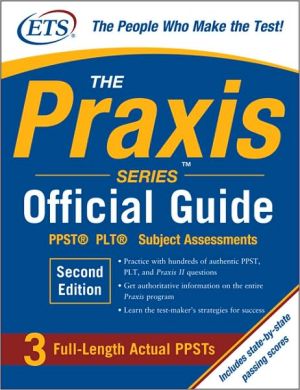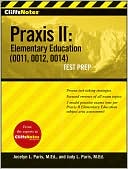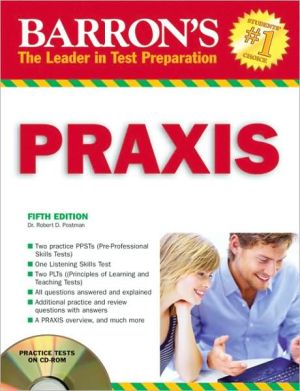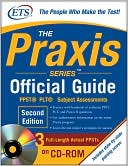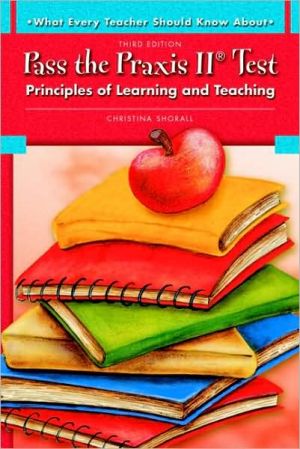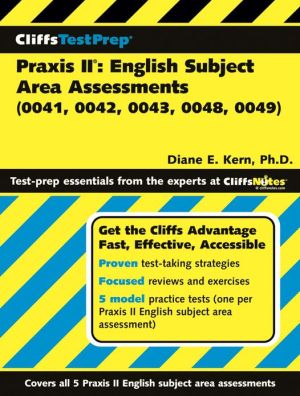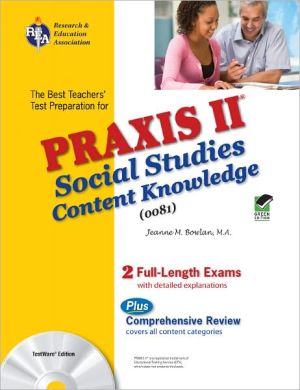PRAXIS Mathematics Content Knowledge (0061) (REA)-The Best Teachers' Test Prep
PRAXIS II Mathematics Content Knowledge (0061)\ For Teacher Certification\ Are you prepared to excel on the PRAXIS II?\ * Get to know the test, how it is scored, and much more.\ * Set up a study schedule by following our flexible, results-driven timeline\ * Take the first practice test to discover what you know and what you should know\ * Use REA's advice to ready yourself for proper study and success\ Sharpen your knowledge and skills\ * The comprehensive review guides candidates through all...
Search in google:
REA … Real review, Real practice, Real results. Take your teaching career to the head of the class. PRAXIS II Mathematics Content Knowledge (0061)For Teacher Certification Are you prepared to excel on the PRAXIS II? * Get to know the test, how it is scored, and much more.* Set up a study schedule by following our flexible, results-driven timeline* Take the first practice test to discover what you know and what you should know* Use REA's advice to ready yourself for proper study and success Sharpen your knowledge and skills * The comprehensive review guides candidates through all the content and process categories on the official test, which is required in most states for certification. Content categories include: Algebra and Number Theory, Measurement, Geometry; Trigonometry, Functions, Calculus, Data Analysis and Statistics, Probability, Matrix Algebra, and Discrete Mathematics.* Lessons reinforce necessary skills* Key tutorials enhance specific abilities needed on the test* Targeted drills increase comprehension and help organize study Practice for real* Create the closest experience to test-day conditions with 3 full-length practice tests* Chart your progress with full and detailed explanations of all answers* Boost confidence with test-taking strategies and experienced advice Get to the head of the class! Get certified! REA books and software have proven to be the extra support teacher candidates need to pass their challenging test for state licensure. Our comprehensive study guides are teacher-recommended and written by educators who have mastered the test and the related program of study.
About This Book\ Introduction: Passing the Test\ \ About the Book\ \ REA’s The Best Teachers’ Preparation for the PRAXIS II Mathematics Content Knowledge Test 0061) is a comprehensive guide designed to assist you in preparing for this required test for teachers of secondary school mathematics. To enhance your chances\ of success in this important step toward your career as a mathematics teacher, this test guide:\ presents an accurate and complete overview of the PRAXIS II Mathematics Content Knowledge Test\ identifies all of the important information and its representation on the test\ provides a comprehensive review of every content category on the test\ provides three full-length practice tests\ suggests tips and strategies for successfully completing standardized tests\ replicates the format of the official test, including levels of difficulty\ supplies the correct answer and detailed explanations for each question on the diagnostic and practice tests, which enable you to identify correct answers and understand why they are correct and, just as important, why the other answers are incorrect.\ \ This guide is the result of studying many resources. The editors considered the most recent test administrations and professional standards. They also researched information from the Educational Testing Service, professional journals, textbooks, and educators. This guide includes the best test preparation materials based on the latest information available.\ \ About the Test\ The PRAXIS II Mathematics Test is designed to assess the mathematical knowledge and competencies for a beginning secondary school teacher. Below are the content and process categories used as the basis for the PRAXIS II Mathematics Test, as well as the approximate percentage of the total test that each category occupies. These categories represent the knowledge that teams of teachers, subject area specialists, and district-level educators have determined to be important for beginning teachers. This book contains a thorough review of all these categories, as well as the specific skills that demonstrate each area.\ \ Who Administers the Test?\ All the PRAXIS II tests are administered by the Educational Testing Service (www.ets.org/praxis).\ \ Content Categories Approx # questions Percentage\ I. Algebra and Number Theory 8 16%\ II. Measurement 3 6%\ Geometry 5 10%\ Trigonometry 4 8%\ III. Functions 8 16%\ Calculus 6 12%\ IV. Data Analysis and Statistics 56 1012%\ Probability 23 46%\ V. Matrix Algebra 45 810%\ Discrete Mathematics 34 68%\ \ Process Categories — Distributed Across Content Categories:\ Mathematical Problem Solving\ Mathematical Reasoning and Proof\ Mathematical Connections\ Mathematical Representation\ Use of Technology\ \ Can I Retake the Test?\ Most states and institutions allow candidates who do not pass the PRAXIS II Mathematics Test to retake it as often as necessary until a passing score is achieved.\ In these cases, candidates must reregister each time they retake a test. However, please check with your state or testing institution for their specific requirements. Candidates\ who have passed a PRAXIS II Mathematics Test have met that part of the testing requirement for certification and, therefore, are not eligible to retake the test again.\ \ When Should the Test Be Taken?\ Individual states, institutions, and associations set their own requirements and passing scores for the PRAXIS. Some states specify the passing of additional or different tests. Check with your state agency for details.\ \ ETS offers the PRAXIS II Mathematics Test six times a year at a number of locations across the nation. The usual testing day is Saturday, but examinees may request an administration on an alternate day if there is a conflict, such as a religious obligation.\ \ To receive information on upcoming administrations of the PRAXIS II Mathematics Test, consult the PRAXIS II Information Bulletin (found here http://www.ets.org/Media/Tests/PRAXIS II/pdf/01361.pdf), or contact the ETS at:\ \ Educational Testing Service\ Teaching and Learning Division\ P.O. Box 6051\ Princeton, NJ 08541-6051\ Phone: (609) 771-7395\ Website: www.ets.org/PRAXIS II\ E-mail: PRAXIS II@ets.org\ \ Is There a Registration Fee?\ There is a fee to take the PRAXIS II Mathematics Test. A complete summary of the registration fees can be found at the website above, or by calling the number above.\ \ Graphing Calculators\ Graphing calculators are required for the PRAXIS II Mathematics Test, so one should be used during your practice tests in this book. On test day, bring your graphing calculator to the testing site as one will not be provided. The ETS states that the calculator should be able to:\ 1. produce a graph of a function within an arbitrary viewing window.\ 2. find the zeros of a function.\ 3. compute the derivative of a function numerically.\ 4. compute definite integrals numerically.\ \ Calculator memories need not be cleared. No calculators with typewriter-type QWERTY keyboards and electronic writing pads are allowed. Please see the ETS website for further details on the types of calculating devices that are prohibited.\ \ How to Use This Book\ \ How Do I Begin Studying?\ \ Review the organization of this test preparation guide.\ 1. To best utilize your study time, follow our PRAXIS II Independent Study Schedule. The schedule is based on a eight-week program, but can be condensed to four weeks if necessary.\ 2. Take the first practice test, score it according to directions, then review the explanations to your answers carefully, studying the areas that your scores indicate need further review.\ 3. Review the format of the PRAXIS II\ 4. Review the test-taking advice and suggestions presented later in this section\ 5. Pay attention to the information about content and the objectives of the test\ 6. Spend time reviewing topics that stand out as needing more study\ 7. Take the second practice test and follow the same procedure as #2 above.\ 8. Follow the suggestions at the end of this section for the day before and the day of the test.\ Note: Graphic calculators should be brought for the test. See the ETS website for details on what to bring to the test site, including which brands and models of calculators are acceptable.\ \ When Should I Start Studying?\ It is never too early to start studying for the PRAXIS II Mathematics Test. The earlier you begin, the more time you will have to sharpen your skills. Do not procrastinate!\ \ An eight-week study schedule is provided at the end of this section to assist you in preparing for the test. This schedule can be adjusted to meet your unique needs. If\ your test date is only four weeks away, you can halve the time allotted to each section, but keep in mind that this is not the most effective way to study. If you have several months before your test date, you may wish to extend the time allotted to each section. Remember, the more time you spend studying, the better your chances of achieving your aim—a passing score on the PRAXIS II Mathematics Test.\ \ Studying for the PRAXIS II Mathematics Test\ It is very important for you to choose the time and place for studying that works best for you. Some students set aside a certain number of hours every morning to study, while some study at night before going to sleep, and others study during the day, while waiting in line, or even while eating lunch. Choose a time when you can concentrate and your study will be most effective. Be consistent and use your time wisely. Work out a study routine and stick to it.\ \ When you take the practice tests, simulate the conditions of the actual test as closely as possible. Turn off your television and radio, and sit down at a quiet table with your graphing calculator. As you complete each practice test, score it and thoroughly review the explanations to the questions you answered incorrectly. Do not, however, review too much at any one time. Concentrate on one problem area at a time by examining the question and explanation, and by studying our review until you are confident that you have mastered the material.\ \ Keep track of your scores to discover general weaknesses in particular sections and to gauge your progress. Give extra attention to the review sections that cover your areas of difficulty, as this will build your skills in those areas.\ \ Format of the PRAXIS II Mathematics Test\ The PRAXIS II Mathematics Test addresses 5 main content categories and 5 process categories.\ \ The content categories were designed to measure the ability to integrate knowledge of mathematics and may involve more than one competency, as well as competencies from more than one content area.\ \ In addition to content categories, the test contains process categories. Entry-level mathematics teachers must demonstrate that they have an understanding of the various ways in which math content knowledge is acquired and used. The process categories (as listed above) test and assess this ability and one or more may be applied to any of the content topics in the test.\ \ There are 50 multiple-choice questions on the PRAXIS II Mathematics Test, and each contains four response options, A through D. You are given two hours to complete the test, so be aware of the amount of time you are spending on each question. Using the practice tests will help you prepare to pace your time evenly, efficiently, and productively.\ \ About the Review Sections\ The reviews in this book are designed to help you sharpen the basic skills needed to approach the PRAXIS II Mathematics Test, as well as provide strategies for attacking the questions.\ \ Each teaching category is examined in a separate chapter. The skills required for all categories are extensively discussed to optimize your understanding of what this PRAXIS II test covers.\ \ Your schooling has taught you most of what you need to succeed on the test. Our review is designed to help you fit the information you have acquired into specific content and process categories. Reviewing your class notes and textbooks together with our reviews will give you an excellent springboard for passing the PRAXIS II Mathematics Test.\ \ Scoring the PRAXIS II Mathematics Test\ Examinees are not penalized for wrong answers. A question answered correctly is worth one raw point, and your total raw score is the number of questions answered correctly on the full test. Passing scores vary from state to state, and test-takers should check with their state board of education for their state’s requirements.\ \ How many correctly answered questions equal a passing grade? According to the ETS, there is no way to predict this. There are several editions of each PRAXIS test, and each edition contains different questions. The questions on one edition may be slightly more difficult (or easier) than those on another edition. To make all editions of a test comparable, the conversion tables adjust for difficulty among editions. There is no way to predict which edition of the test you will take next.\ \ Score Results\ Your test scores will be mailed approximately four weeks after test day to those who you designated to receive them. There is a fee for each additional score report requested.\ \ Test-Taking Tips\ If you are not familiar with tests like the PRAXIS II Mathematics Test, this book will help acquaint you with these types of tests and help alleviate your test-taking anxieties. Listed below are ways to help you become accustomed to the PRAXIS II Mathematics Test, some of which may be applied to other tests as well.\ \ Tip 1. Become comfortable with the format of the test. When you are practicing, stay calm and pace yourself. After simulating the test only once, you will boost your chances of doing well, and you will be able to sit down for the actual test with much more confidence.\ \ Tip 2. Read all of the possible answers. Even if you think you have found the correct response, do not automatically assume that it is the best answer. Read through each choice to be sure that you are not making a mistake by jumping to conclusions.\ \ Tip 3. Use the process of elimination. Go through each answer to a question and eliminate as many of the answer choices as possible. By eliminating two answer choices, you have given yourself a better chance of getting the item correct since there will be only two choices left from which to make your guess. Answer all questions you can; you are not penalized for wrong answers, but you are rewarded for correct ones.\ \ Tip 4. Place a question mark in your answer booklet next to answers you guessed, then recheck them later if you have time.\ \ Tip 5. You will have two hours to complete the test, so work quickly and steadily to avoid focusing on any one problem too long. Taking the practice tests in this book will help you learn to budget your precious time.\ \ Tip 6. Learn the directions and format of the test. This will not only save time, but also help you avoid anxiety (and the mistakes caused by getting anxious).\ \ Tip 7. Be sure that the answer circle you are marking corresponds to the number of the question in the test booklet. Since the test is multiple choice, it is graded by machine, and marking one answer in the wrong circle can throw off your answer key and your score. Be extremely careful.\ \ The Day of the Test\ \ Before the Test\ On the day of the test, make sure to dress comfortably so that you are not distracted by being too hot or too cold while taking the test. Plan to arrive at the test center early. This will allow you to collect your thoughts and relax before the test, and spare you the anguish that comes with being late.\ \ You should check your PRAXIS II Mathematics Content Knowledge Test information bulletin or registration information to find out what time to arrive at the testing center.\ \ Before you leave for the test center, make sure you have your admission ticket and two forms of identification, one of which must contain a recent photograph, your name, and signature (i.e., driver’s license). You will not be admitted to the test center if you do not have proper identification.\ \ You must bring several sharpened No. 2 pencils with erasers and an approved graphic calculator (see above) as none will be provided at the test center.\ \ If you would like, you may wear a watch to the test center. However, you may not wear one that makes noise, because it may disturb the other test-takers. Dictionaries, textbooks, notebooks, briefcases, laptop computers, or packages will not be permitted. Drinking, smoking, and eating are prohibited.\ \ During the Test\ The PRAXIS II Mathematics Test is given in one sitting with no breaks. Procedures will be followed to maintain test security. Once you enter the test center, follow all of the rules and instructions given by the test supervisor. If you do not, you risk being dismissed from the test and having your scores canceled.\ \ When all of the materials have been distributed, the test instructor will give you directions for filling out your answer sheet. Fill out this sheet carefully since this\ information will be printed on your score report. Once the test begins, mark only one answer per question, completely erase unwanted answers and marks, and fill in answers darkly and neatly.\ \ After the Test\ When you finish your test, hand in your materials and you will be dismissed. Then, go home and relax—you deserve it!\
CONTENTS CHAPTER 1INTRODUCTION: PASSING THE TESTAbout This Book About the Test How to Use This Book Studying for the PRAXIS II Mathematics Test Format of the PRAXIS II Mathematics Test About the Review Sections Scoring the PRAXIS II Mathematics Test The Day of the Test PRAXIS II Mathematics Study Schedule CHAPTER 2ALGEBRA AND NUMBER THEORY Integers and Real Numbers Rational and Irrational Numbers Real Numbers and Their Components Algebra Terms Operations with Polynomials Simplifying Algebraic Expressions Linear Equations Slope of the Line Two Linear Equations Quadratic Equations Absolute Value Equations Inequalities Vectors Ratio, Proportion, and Variation CHAPTER 3GEOMETRY, MEASUREMENT AND TRIGONOMETRY Points, Lines, and Angles Congruent Angles and Congruent Line Segments Triangles Quadrilaterals Solid Geometry Coordinate Geometry Conic Sections Trigonometry Angles and Trigonometric Functions CHAPTER 4FUNCTIONS AND CALCULUSElementary Functions Properties of Functions Graphing a Function Polynomial Functions and Their Graphs Calculus: Limits The Derivative Application of the Derivative The Definite Integral CHAPTER 5DATA ANALYSIS, STATISTICS AND PROBABILITY Probability Properties of Probabilities Methods of Computing Probabilities Bayesian Decision Analysis Probability Tables Counting Methods Data Description: Graphs Numerical Methods of Describing Data Measures of Variability Sampling Simple Linear Regression Experimental Design CHAPTER 6MATRIX ALGEBRA AND DISCRETE MATHEMATICS Discrete Mathematics Sequences and SeriesRelations Linear Equations and Matrices Matrices Matrix Arithmetic CHAPTER 7MATHEMATICAL REASONING, PROOF, CONNECTIONSBasic Concepts of Logic Method of ProofMathematics as Communication Defining Objects and Concepts in Mathematics The Language of Mathematics Beyond Words Mathematical Connections Mental Connections Equivalent Representations Relationships Between Mathematical Topics Representations of Arithmetic Operations PRACTICE TEST 1 Sample Mathematics Definitions and Formulas Answer Sheet Practice Test Answer Key Practice Test: Detailed Explanations of Answers PRACTICE TEST 2Sample Mathematics Definitions and Formulas Answer Sheet Practice Test Answer Key Practice Test: Detailed Explanations of Answers PRACTICE TEST 3 Sample Mathematics Definitions and Formulas Answer Sheet Practice Test Answer Key Practice Test: Detailed Explanations of Answers INDEX

